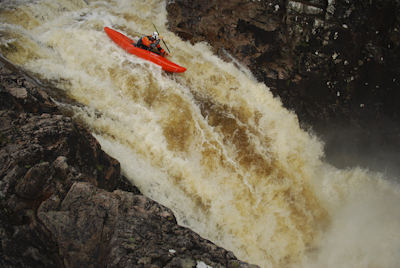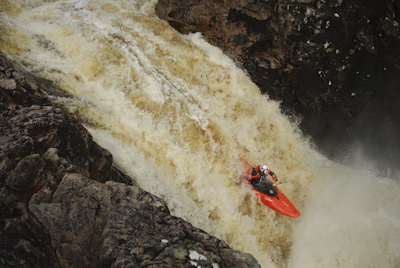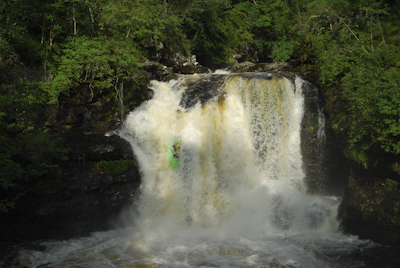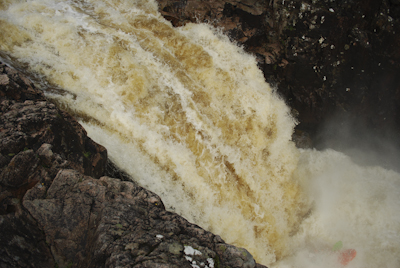Running drops, an intro
Pre-requisites
It should go without saying that having solid gear and safety ready, along with the knowledge to use it is a must and if you don’t, getting hands on instruction from full time instructors such as Simon and the crew at Gene17 is a good idea before proceeding. Apart from that, running drops can often be more of a mental control so being conscious of when you’re good to go and when you should take a walk is worth thinking about.
Lead in
With many drops it’s often the lead in that posses the biggest problems. There’s a couple of basic things that will help you be where you want to be as you go off the lip of a fall. The first thing is keeping good posture in your boat with your head up looking where you want to be. Looking at where you don’t want to be is the surest way to end up in trouble. The second thing seems ridiculously simple, but actively paddling with positive strokes can be something that people forget in focusing all their attention on the freefall. It might be an idea to time your strokes on the lead in so you know what your paddling is doing when you launch…
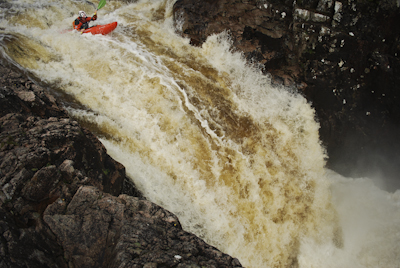
Positive posture and strokes.
Launch
Launching off a waterfall is the bit where a lot people freeze. This is due to the very brief heart stopping moment, which causes people to stop paddling and look down in horror. A bad take off generally means a bad landing!
At the lip of a fall, once again look where you want to be going. Obviously down, but few waterfalls are perfect, so most of the time we want to be landing in a particular place or at a particular angle. As you look where you want to land, plant a stroke which will help you maintain control as you follow it through and use it as a leaver for you to change both body and boat angle if needed in the freefall.
Looking for the landing with a guide stroke planted.
Freefall
During freefall I don’t take my eyes off where I’m wanting to land, but one of the most important things to me in freefall, is to keep your body in an upright or slightly forward position, ready for action. Leaning back is a sure way to come out of the bottom a bit sore, by keeping upright or forward you keep control. If you are in a position where you need to pull the bow up because you have too much angle, you can move your body slightly back and use the active body momentum to pull your legs and boat up. On the other hand if you are falling with a flat angle then a good shunt forward should help your bow drop and arch into freefall.
As my body moves in a freefall my paddle follows for leverage – if I need to drop the bow my arms and paddle are over the bow. If I need to pull the bow up, I pull my arms and paddle back.
Keeping active to control angle through the freefall.
Landing
The main objective in landing is to minimize the impact and maximize your get away chances. On smaller bigger volume drops with a constricted landing this may mean an almost boof technique to avoid getting stuffed into any nooks and crannies but stomping the bow down at the last minute by quickly shoving the body forward and legs down to avoid shock through the spine.
But more often the case with drops where we want to enter the water at an angle between 45 degrees and vertical, it’s a split second tuck, folding away the head, shoulders and paddle. Shoulders should be turned at an angle so they aren’t face on to the water – around 45 degrees – your paddle should be kept parallel with your shoulders and elbows bent to avoid any wrenching. Having shoulders and paddles parallel keeps you stable and solid.
I like to keep my eyes on my landing pad as long as I can, so I generally keep my head up on falls around the 25 foot mark, as there doesn’t tend to be too much impact if things go to plan. On larger falls, or if things don’t go to plan, tilting your head down and to the side means that the top of your helmet will take most of the impact and there is less chance of your nose making impact with your cockpit rim.
If things go horribly wrong and you’re heading for a flat landing, the forward shove mentioned earlier will aid to prevent the shock from traveling up your spine. However this may provide you with the harsh alternative of your face making contact with your cockpit or deck but given the options, my face is no where near pretty enough to take the risk.
Different fall but Dave Martin in landing gear.
Recovery
If everything goes well, all you may need for a recovery is to shake the water out of your eyes before heading on downstream. If you’ve gone deep, then trying to get your body forward as you’re under water will help you resurface in a stable position. If you end up upside down then a quick roll will help you be in position for the next rapid or prevent you from heading into that corner where you don’t want to be.
Posture and paddle placement helping me prevent a back-loop and getting stuffed.
Overview
- Have the right equipment and knowledge.
- Don’t get pushed off line before you’re at the edge.
- Spot your landing and paddle for it as you launch. Don’t freeze.
- Keep your body active in freefall to maintain a good angle.
- Tuck up to reduce surface impact on landing.
- Be on the ball for the next rapid or any hazards.
Next update will be from last weekends surf trip to Machrihanish!
See you on the water
Ed
Please Leave a Reply
TrackBack URL :








